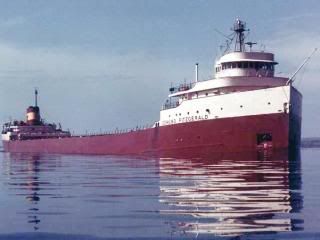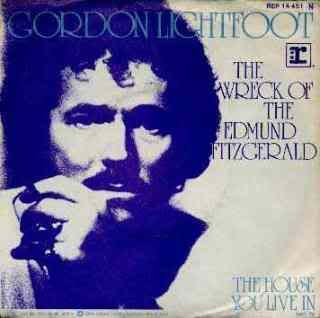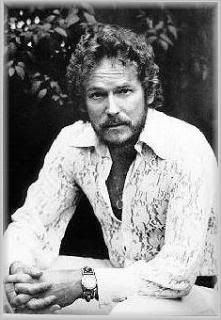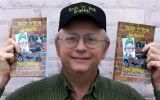
Gordon Lightfoot's "Wreck of the Edmund Fitzgerald"
still evokes strong emotions in people who remember when
the ore carrier sank in 1975, claiming the lives of all
29 crewmen.
By STEVE SEYMOUR
Gordon Lightfoot's "Wreck of the Edmund Fitzgerald" may the greatest song about the greatest maritime mystery on the Great Lakes, but it wasn't the first one.
Millions remember Lightfoot's tribute song, which first charted on Aug. 28, 1976, nine months after the giant ore carrier sank on Nov. 10, 1975 with the loss of all 29 crew members.
Fewer may recall "Twenty-Nine More Men," by Charlie Frederick, an earlier salute to the crew of the doomed vessel.
A native of West Virgina, Frederick learned to love music after his mother gave him a guitar when he was 12 years old.
By the mid 1970s, Frederick was living in Minnesota where he worked as an assistant professor at the Duluth campus of the University of Minnesota.
He spent time watching freighters, such as the Fitz, which on this ill-fated trip was transporting 26,000 tons of taconite from the mines of Minnesota to a steel mill on Zug Island, near Detroit.
Frederick's ears immediately perked up when he heard news that the 729-foot Fitz had sunk about 17 miles from Whitefish Bay during a vicious Lake Superior gale.
The carrier suffered under winds reaching 80 miles an hour and waves up to 25 feet high, before descending to its watery grave.
"I followed the events as they were being reported by television reporters. I was simply overwhelmed by the news," Frederick said.
The Detroit News reported the story under the banner headline: "Freighter sinks; crew of 29 is hunted in Lake Superior."
"Over the next three days, I began writing the song, which would later be recorded in Nashville," the musician explained.
Frederick composed and performed "Twenty-Nine More Men," which he gave a country-music treatment.
"Great Lakes storms are wild and mean; they've conquered men before," he sang.
While Frederick wrote a moving tribute to the victims of the Fitzgerald tragedy, his song paled in comparison to the impact of Lightfoot's track.
"Wreck of the Edmund Fitzgerald" spent 21 weeks on the pop music chart in the fall of 1976, including two weeks at No. 2. It was kept from the top spot by Rod Stewart's "Tonight's the Night."
Lightfoot's majestic song stirred people's emotions and has remained a staple on radio.
The song was nominated for a Grammy as Song of the Year, but lost to "I Write the Songs," by Barry Manilow.
Over the years other acts have interpreted Lightfoot's classic tune.
Indianapolis-based Simon Barr Sinister recorded a heavy-metal version which made the playlist at a number of stations in the Great Lakes area, including WIMK-FM in Iron Mountain.
The band consisted of Donnie Saint Thomas (lead vocals, keyboards), Richie Wilkerson (electric and acoustic guitars, vocals), Bo (bass) and Dan "Taz" Devlin (drums, percussion, vocals).
Named after the main antagonist in the 1960's cartoon show "Underdog," the group has released two extended play discs and a full-length CD.
"Advance CD" was issued in 1995, "Unmastered" was released in 1997, while the 13-track "Simon Barr Sinister" appeared in 2003.
Knowing what their fans wanted to hear, all three compact discs contained the group's hard-rock arrangement of "Wreck of the Edmund Fitzgerald."
Portland Oregon's Dandy Warhols, on the other hand, recorded a notable version on their "Come On Feel the Dandy Warhols" album. 
Lightfoot's classic narrative has special meaning to the band since lead singer Courtney Taylor-Taylor was a cousin to 37-year-old Michael E. Armagost, who died in the sinking.
A resident of Iron River, Wis., Armagost was third mate on the Fitz, which was named after a Milwaukee ship builder.
The Dandy Warhols recorded a second, psychedelic version of "Wreck of the Edmund Fitzgerald" for their "Black Album."
Canadian band Clay recorded their take on the song for their debut full-length album, "Marigolds & Zenia."
Fellow Canadians the Tragically Hip played the number in an encore in Cleveland, although it isn't on any of their albums. Located on Lake Erie, Cleveland was the home base of the Oglebay Norton Co., Columbia Transportation Division, which operated the Fitz.
An act called Brigid's Cross even recorded a Celtic version of Lightfoot's masterpiece.
Virginia-born musician Tony Rice has issued a 17-track compilation of Lightfoot material, including an acoustic "Wreck of the Edmund Fitzgerald," complete with his trademark bluegrass pickin'.
Lightfoot's original 5-minute and 30-second recording was first included on his "Summertime Dream" album.
The record featured Gordon Lightfoot (lead vocals, 12- and six-string guitar), Terry Clements (lead acoustic and electric guitars), Rick Haynes (bass), Pee Wee Charles (steel guitar) and Barry Keane (drums and percussion).
Lightfoot was born in 1938 in Orillia, Ontario, Canada and began showing his musical abilities at an early age.
He first recorded for the Chateau label in 1962 and signed to Reprise Records in 1970. The folk singer's only American No. 1 hit was "Sundown" on June 29, 1974.
"Wreck of the Edmund Fitzgerald," meanwhile, reached its sales and airplay peak about the time of the first anniversary of the tragedy in 1976.
Now immortalized, Lightfoot's words continue to echo across the years.
"The legend lives on from the Chippewa on down, of the big lake they call Gitche Gumee...."


 I've enjoyed rock music and writing since I was a teenager in the 60s. I feel lucky to have been around when rock's greatest stars created their most enduring hits. At the same time I found I enjoyed writing, as well. I worked on my high school newspaper and magazine, was editor of several college publications and earned a bachelor's degree from Central Michigan University in 1973. I worked for the daily newspaper in my hometown after graduating, becoming managing editor after a few years. By the 1980s, I moved into public relations. In 1985, my wife Sue and I opened a retail music store, The Record Rack, which we still own. Rock 'n' roll has been integral to me and for the last 2O years I've been earning my living from it even though I don't have a musical bone in my body. In recent years, I've also I edited a small local magazine and launched a micro FM radio station. Now, I'm finally combining my love of writing and rock 'n' roll. I can't sing a note, but I know what I like. I'll tell you all about it when you read on. I hope you have as much enjoyment reading these installments as I've had writing them.
I've enjoyed rock music and writing since I was a teenager in the 60s. I feel lucky to have been around when rock's greatest stars created their most enduring hits. At the same time I found I enjoyed writing, as well. I worked on my high school newspaper and magazine, was editor of several college publications and earned a bachelor's degree from Central Michigan University in 1973. I worked for the daily newspaper in my hometown after graduating, becoming managing editor after a few years. By the 1980s, I moved into public relations. In 1985, my wife Sue and I opened a retail music store, The Record Rack, which we still own. Rock 'n' roll has been integral to me and for the last 2O years I've been earning my living from it even though I don't have a musical bone in my body. In recent years, I've also I edited a small local magazine and launched a micro FM radio station. Now, I'm finally combining my love of writing and rock 'n' roll. I can't sing a note, but I know what I like. I'll tell you all about it when you read on. I hope you have as much enjoyment reading these installments as I've had writing them.


1 comment:
Lightfoot's Wreck of the Edmund Fitzgerald is memorable also because while it is a stirring narrative in its own right it still contains one of the dumbest lines in recorded music: "As big freighters go, it was bigger than most!"
Come on now Mr Lightfoot, you could have rephrased that one line to make it less absurd. You had me interested until I heard that and I laughed.
Post a Comment